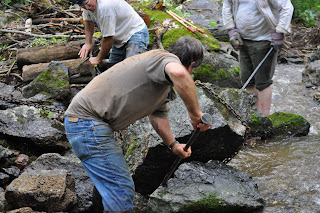On Saturday May 21 a group of the loyal volunteers of the Mountains to Sea Trail Crew gathered to create new trail foot tread and to put the creek back in the creek.
It is always inspiring to see old friends and meet new friends early in the fresh morning.
Folks who build trails together forge a team.
There are the leaders, organizers, and planners who coach us forward. Ashe County and Watauga County Task force leaders John Lanman and Jim Hallsey make plans and organize the effort.The task force receives directions and locations to work and begins to gather the tools, gather the strength,
and muster the courage to climb that mountain one more time for the good of the cause.
I was assigned to the creek recovery team and we headed north to the work site. This location required getting into the creek and removing wash, debris, trees, and stone from the creek bed. We were working south of the convergence of Goshen Creek and High Shoals Creek.
Our sawyers went in first. With great difficulty while standing in the river, they skillfully cut up the jammed dams of winterfall and storm debris that had lodged in the creek around rocks and bolders. The clearing team then began to remove the flotsam from the logjams.
Professor Allen DeHart supervised and inspired us to get into the creek and open the channels that would allow the natural and unobstructed flow of the creek.
One of our elder trail volunteers and founder of the FMST, Allen DeHart explained that in 1998 when he first surveyed the area the trail path we are developing was an old road bed. In the last 12 years debris had created dams upstream which diverted water flow into our trail. Our work of the day was to open the blockage, recover the creek bed, and redirect the creek into its natural channel away from the trail and parkway.
We were fortunate to have student volunteers from the ASU Trail Crew join us on this day. Five strong workers gave us help and inspiration. It is always rewarding to see youngsters showing an interest and passion for the future of our trails.
We must cultivate interest in trails for the generations to come. Most people do not understand that if we are going to have our existing trails in the futurethey will be maintained by the youngsters of today. For once in time, we were they; and in time, they will be we the few.

And if there will be new trails created after we are gone it will be because we teach and share our passions; not just for hiking on trails, but for the process and the journey of building new trail.
Working together with volunteers of all ages teaches the next generation of Friends of the Trails
the techniques and methods we used to bring them to this point along their journey as it intersects with our trail.Chris ponders a solution to a problem at hand. I like to see obstacles as a challenge. When I call them problems, it is in the climbers context. The route is the path, and the problem is the challenge, an opportunity to overcome and resolve a problem. Often trail work is just that, a series of problems waiting for a solution to be discovered.
After moving many smaller boulders with muscle, rock bar, and fulcrum we were faced with the challenge of removing a large boulder that remained in the very middle of the channel we were opening. Once we found it would "wiggle" we had to develop a plan to move it!
Gary showed up with his "come along" and cable. Bruce had a mighty chain and we hooked it around the boulder. Anchored to the tree Gary began to set the tension on the come along.
Watch and learn~
With the use of a simple machine, a lever and pull, we can move mountains. Well, at least pieces of mighty and ancient terra firma.
With the pry bar and muscle Bruce maneuvers the boulder into the shoulder of the creek.
You can see the chain doing the pulling as these two pry bars set the stone in place.
Why would we do all this may be your thought at this point? Because from that boulder reinforced bend in the river we could build our creek side berm.
By moving all of the large stones to the side of the creek on the left we made a new shoulder to push the water toward its natural bend.
Where just a few hours ago there were years of logjam and debris filling this run, now there are cascades, a spill way for the flow, where the river will go.
To give you a better idea of the size of these stones, use my trail hat for scale.
All the stones in front of it we placed to build our berm.
Our trail will now have a dry foot tread,
the creek will not flow in our path.
The water has been returned to the river.
The flow of the river and tread of trail are parallel in natural harmony.
The work of the day a memory.
Let it flow.
Let it flow.




































